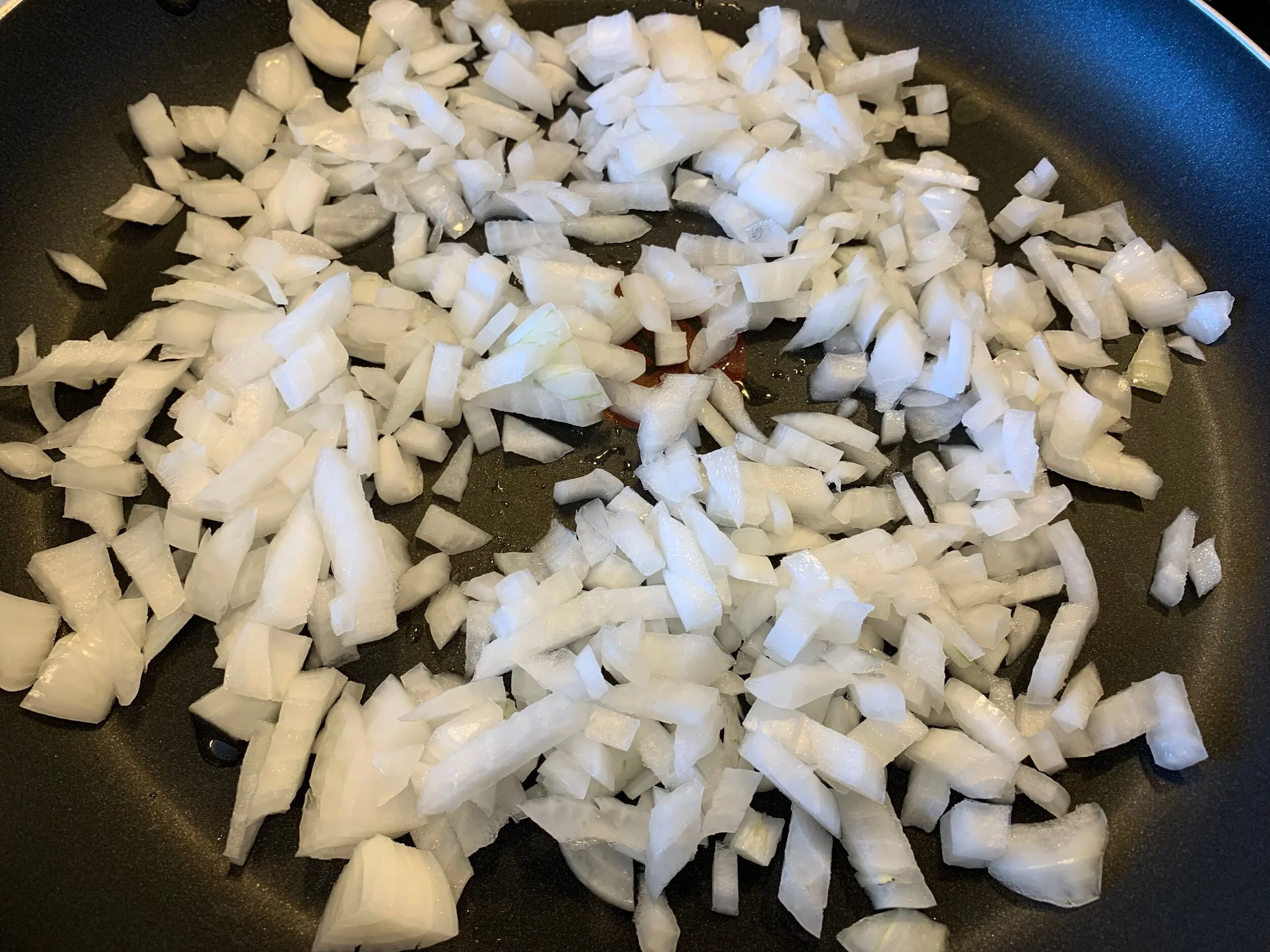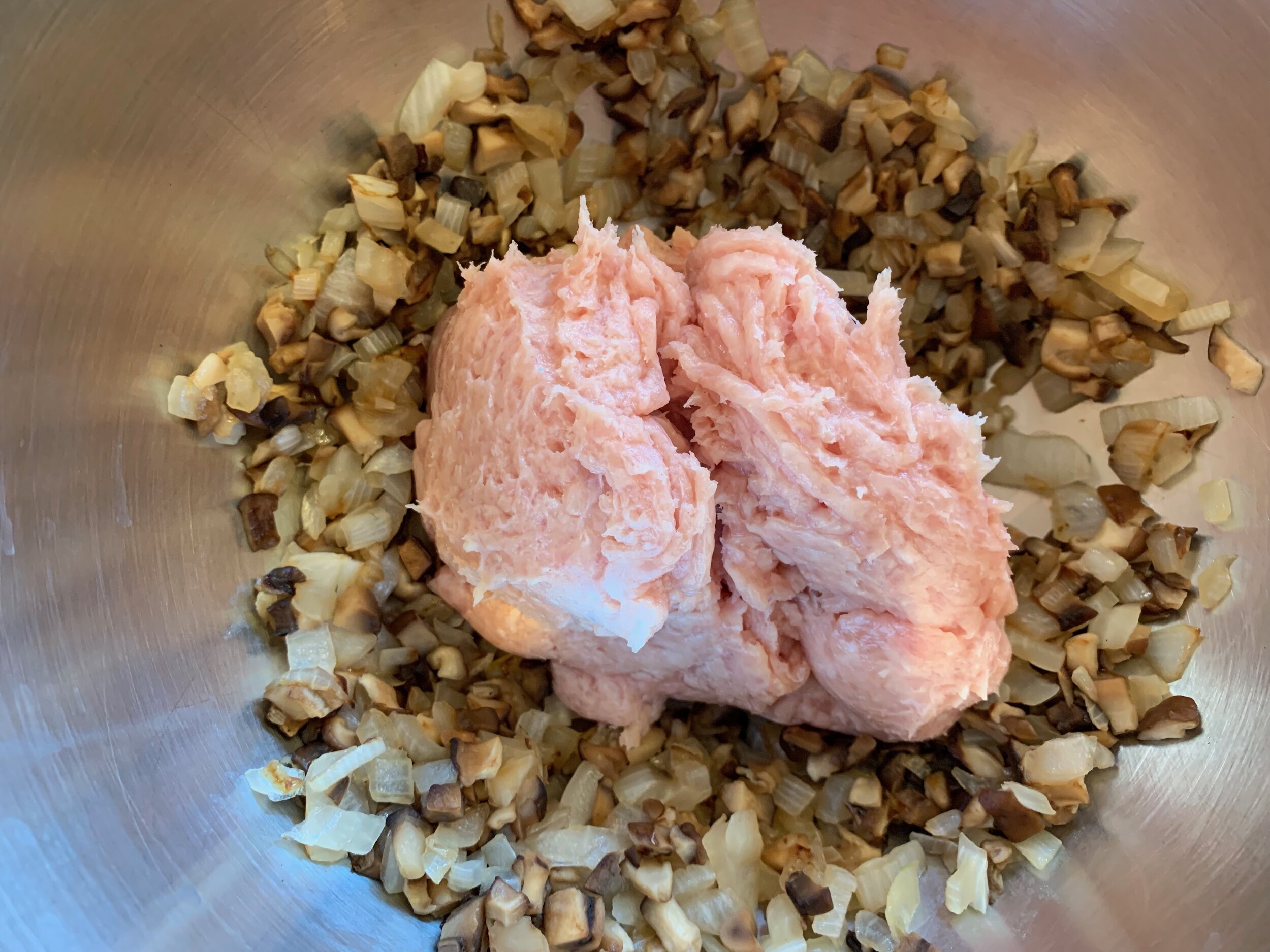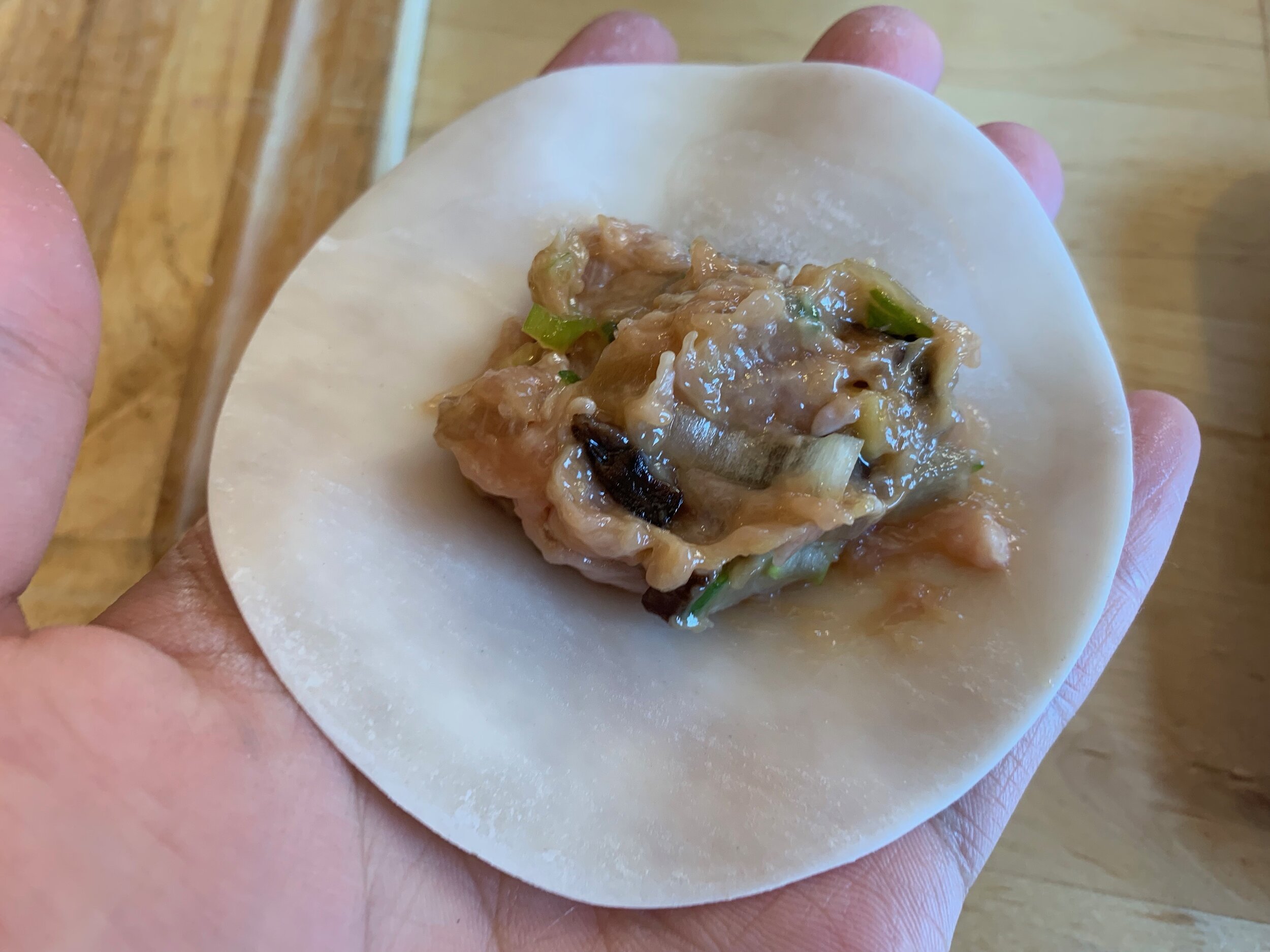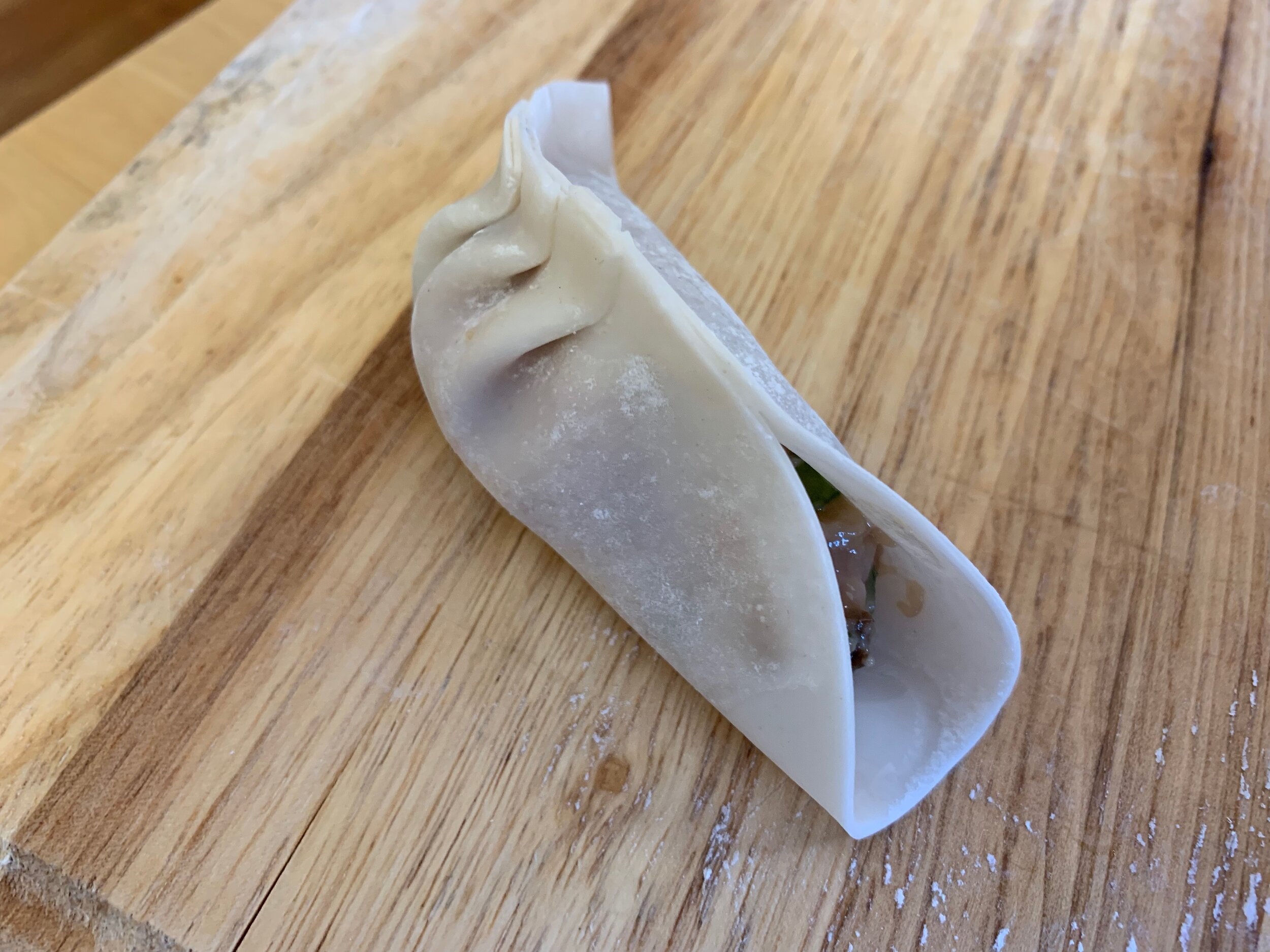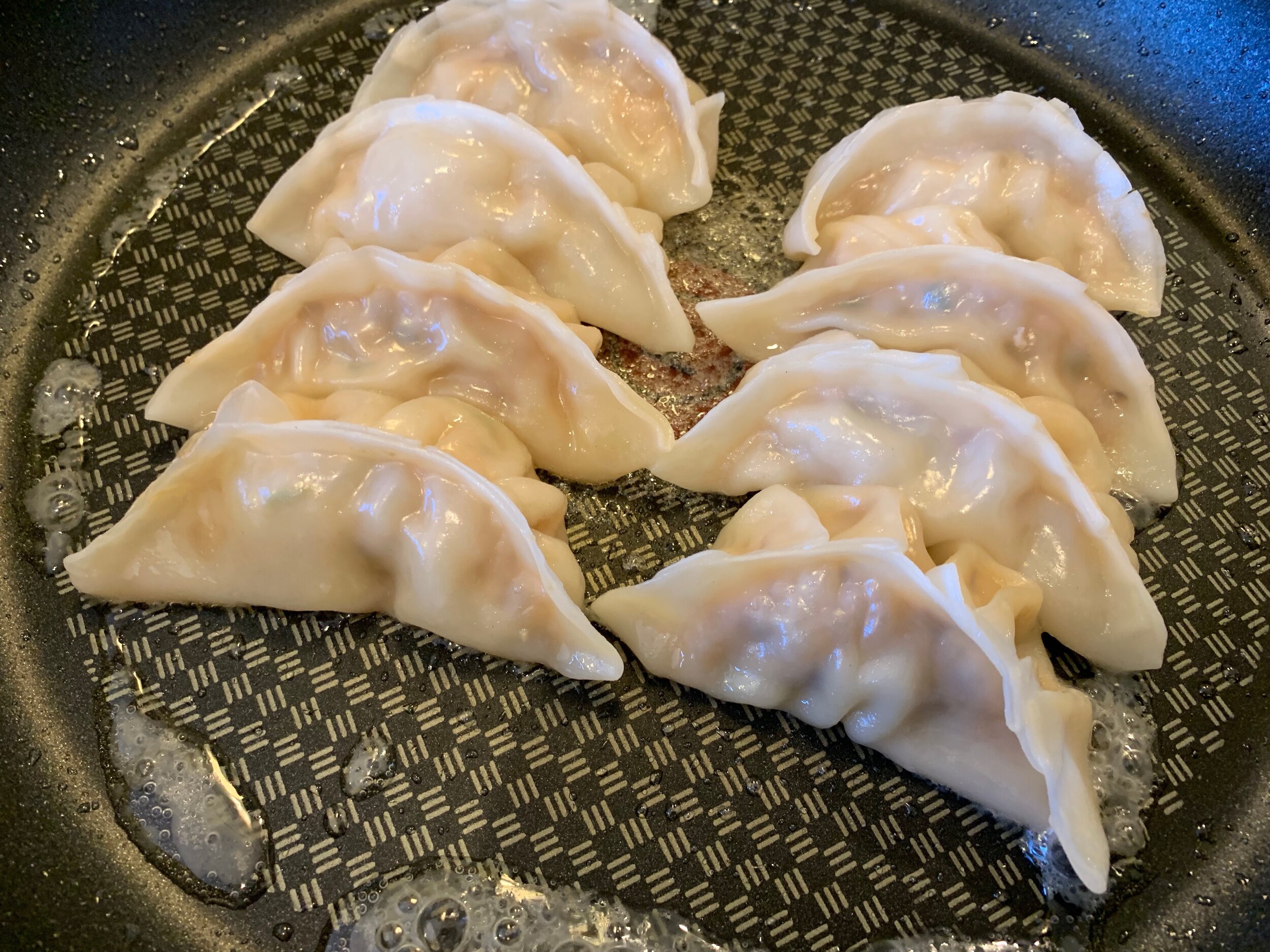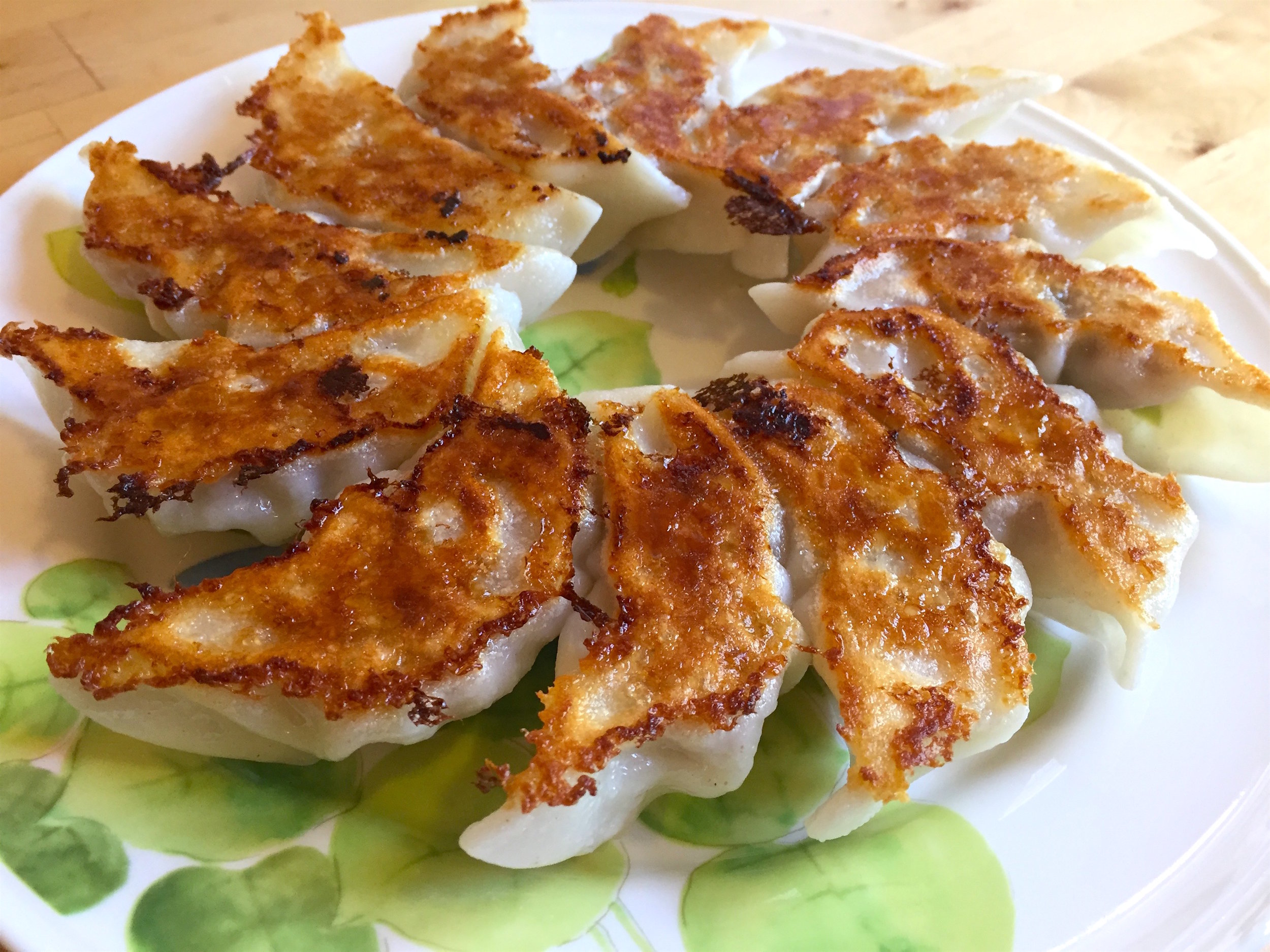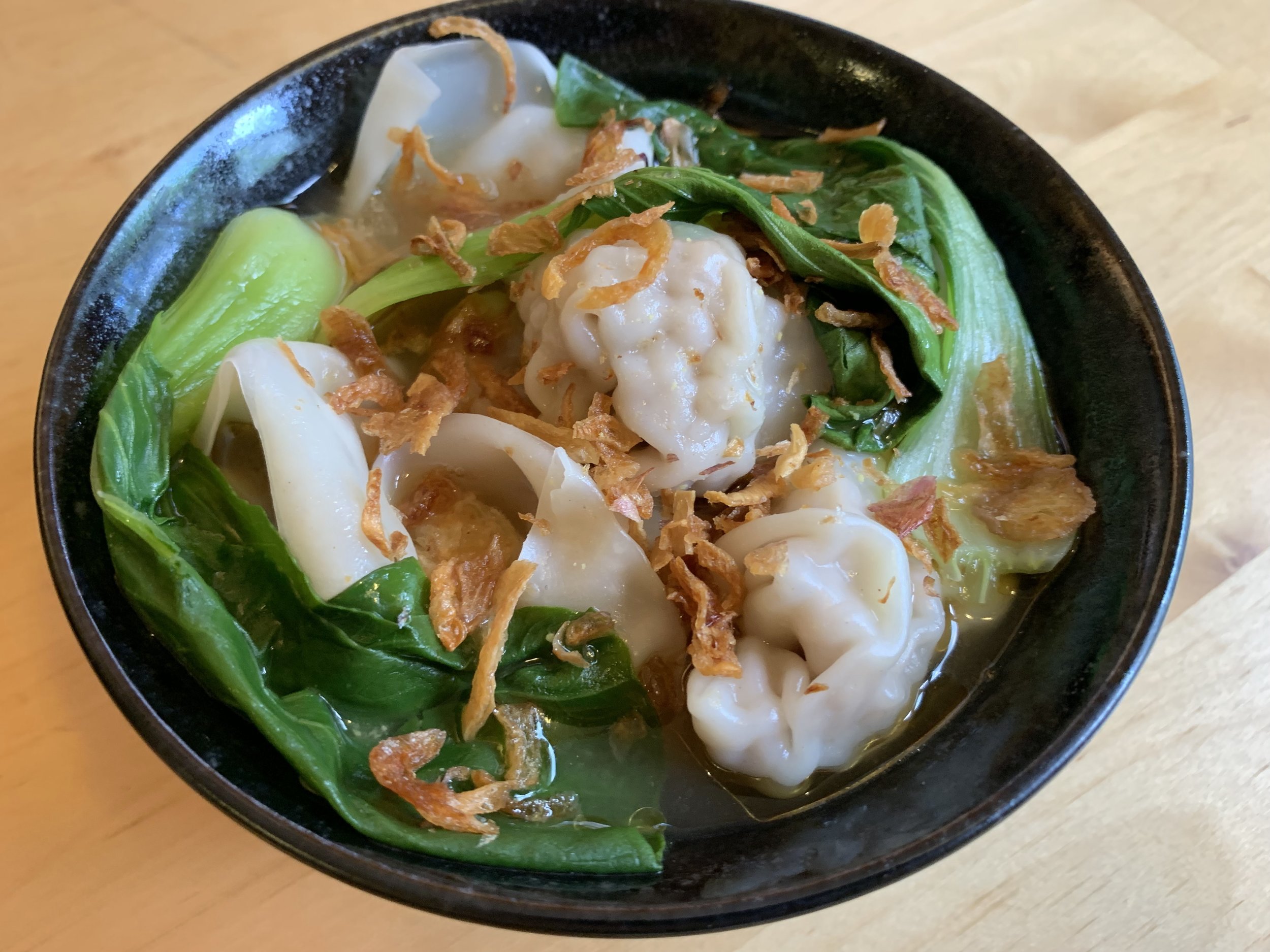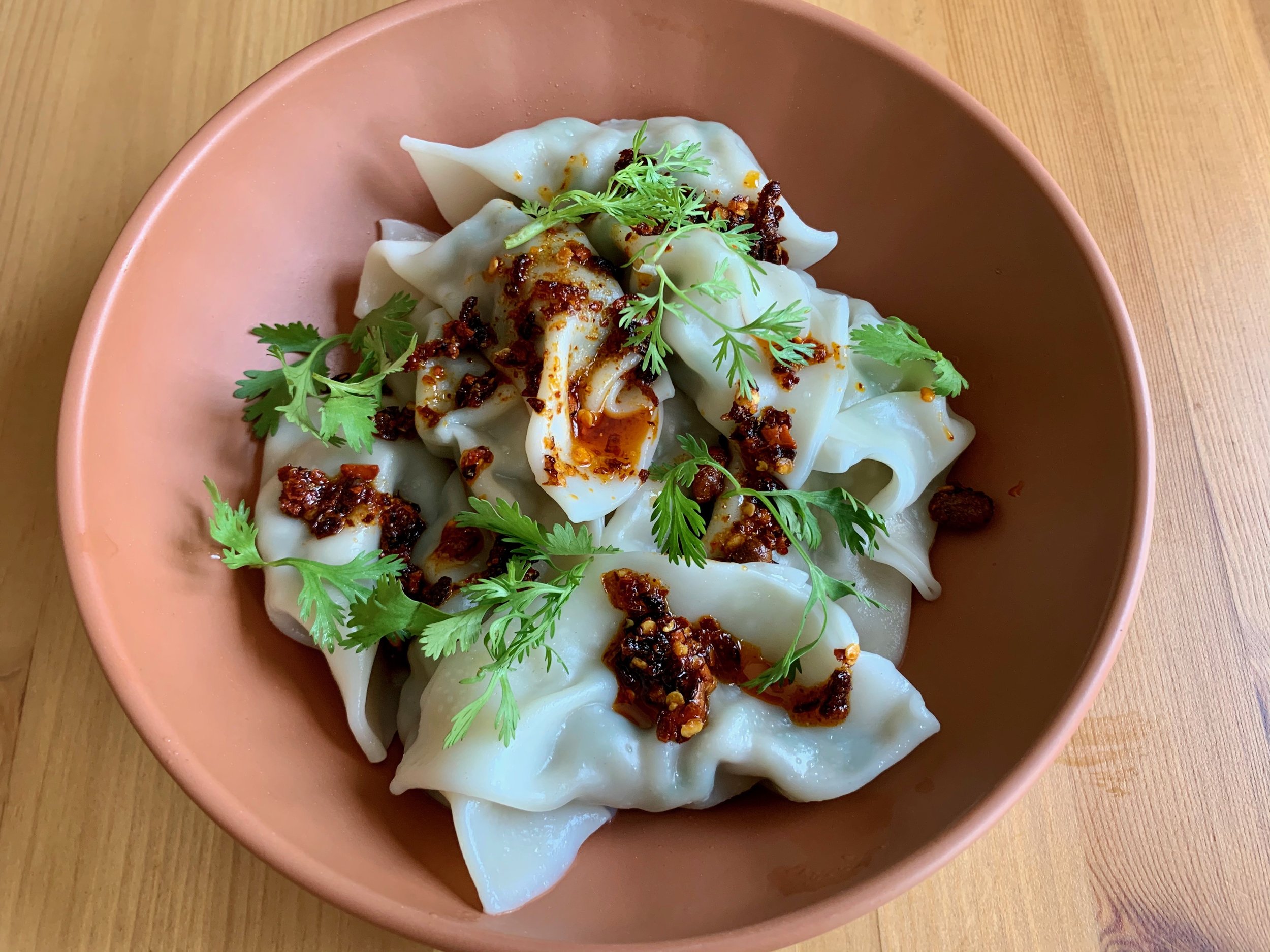Chicken and Mushroom Dumplings

雞肉香菇餃子
(Ji Rou Xiang Gu Jiao Zi)
Dumplings are ubiquitous in Chinese cuisine, coming in many forms and with many fillings.[1] While pork is the most common protein used to fill dumplings, you can make great chicken dumplings as well. This recipe makes juicy, savory dumplings with chicken and shiitake mushrooms.
Making dumplings at home is cheaper than store-bought dumplings, and gives you greater control over the flavor and quality of the final product. Additionally, they freeze well, giving you a convenient homemade meal if you have made them in advance. Wrapping dumplings together is often a family activity in Chinese households, and it is a great way to spend time with family or friends!
Ingredients
1 lb ground chicken thighs
8 shiitake mushrooms (5 oz), diced
1 pkg round dumpling wrappers
1 onion, finely diced
2 scallions, chopped
1½ inch ginger, minced
1 tbsp cornstarch
1 tbsp soy sauce
2 tsp sesame oil
1 tbsp Shaoxing rice wine (optional)
1 tbsp sugar
½ tsp salt
Vegetable oil
The biggest challenge when it comes to making chicken dumplings is to keep them moist. Chicken is a very lean meat, and therefore usually has fine margins for doneness. However, the doneness of chicken in dumpling form cannot be easily judged, and as a result, chicken dumplings, once cooked, are often tough and disappointing. A common strategy for combating this is to mix the chicken with a fattier meat, such as pork. However, this is a bit of a cheat, particularly if dietary restrictions are in play. One could try to compensate by loading up on leafy vegetables, but the water they release during cooking will compromise the structural integrity of the dumplings. So what should be done?
Our strategy for juicy chicken dumplings has two prongs—first, we will use ground chicken thigh meat, which has more fat than chicken breast meat (and also tastes better).[2] Second, we will employ mushrooms and onions to bring some moisture. Both mushrooms and onions will retain some of their moisture when boiled in the dumpling. The meaty flavor of mushrooms will also give the chicken a helpful assist in the flavor department.
However, adding the onions and mushrooms raw will still cause too much water to be released inside the dumpling. We must therefore cook them down before we add them to the filling. Finely dice both the onion and mushrooms, and heat about a tablespoon of vegetable oil in a skillet over medium heat. Once the oil is hot, add the diced onion. Cook for 5 minutes, stirring occasionally, until it has softened. Then add the mushrooms to the skillet and continue cooking uncovered for 10 minutes, until the mushrooms have softened, darkened, and given up some of their water and absorbed some of the oil. The skillet should be dry at this stage. Remove the onion and mushroom mixture from the heat and set aside to cool for at least 10 minutes.
While the onions and mushrooms cool, finely mince the ginger, and finely chop the scallions. Then add the ginger, scallions, soy sauce, sesame oil, rice wine, white pepper, and cornstarch to the ground chicken. The cornstarch is another layer of insurance against a filling that is too wet, as it will absorb moisture and help bind the filling together. Mix the the filling together using a large spoon or clean hands, until the mixture is homogeneous.
At this point you will want to check for seasoning—the best way to do this is to take a small scoop of the filling and microwave it for 30 seconds or so, until it’s fully cooked. Adjust the seasoning to your taste, then prepare to wrap. You can prepare the filling up to two days in advance of wrapping if you wish. Cover tightly and store in the refrigerator.
On a clean table or counter, prepare a workspace for wrapping the dumplings. The dumpling wrappers, if frozen, should be fully thawed. It is important to stop the wrappers from drying out, so depending on how fast you can work, and how humid the air is, it is often a good idea to keep the wrappers covered before wrapping, either with plastic wrap or a clean tea towel. A towel is also useful for drying your fingers. Fetch a small bowl of cold water for sealing the dumplings, and prepare a landing zone for the completed dumplings. If you plan on cooking them all immediately, just go and pile the dumplings up on a plate, but if you are planning on freezing the dumplings, prepare a plate, cutting board, or sheet pan covered in plastic wrap or parchment paper. The dumplings should be placed in a single layer with a small amount of distance between them so they freeze individually.
If you want to make them in the traditional crescent shape, begin by placing a wrapper in the palm of your hand and scooping about 1 tablespoon of filling into the center of the wrapper. The ideal amount of filling will depend on the size of your wrapper, so adjust this amount as you go. With your other hand, dip a finger in the cold water and run it around the whole perimeter, moistening the edge of the wrapper. This very small amount of water is meant to help the wrapper to stick to itself—it should not be enough to form droplets or run. Dry your finger on the towel, and then pinch the wrapper together at the top. Then, begin to seal the dumpling by crimping the seam. Pinch the wrapper to itself on one side, forming a pleat. Then press the pleat back to the other side of the wrapper, sealing it. Repeat this process two or three more times, until one side of the dumpling is sealed. Pleating the dumpling wrapper only on one side creates a gentle curve to the seam. Repeat the process on the other side, being sure that all the air gets out.
When you are done wrapping, if you intend on freezing the dumplings, put your parchment or plastic wrap lined surface into the freezer. After 6 hours or so, the dumplings should be rock solid. Transfer into a zipper storage bag for convenient storage in the freezer.
When it comes to cooking the dumplings, the two most common methods are boiling and pan frying.
To Cook (Boiled)
Boiled dumplings (水餃) are the most common home preparation of dumpling, and the simplest to execute. The only big problem to avoid is the dumplings coming apart when cooking. To avoid this, minimize the turbulence in the water by keeping the pot from reaching a rolling boil.
In a large pot, bring water to a boil. When the water is boiling, add the dumplings to the pot, stirring several times to prevent sticking. As with cooking pasta, use a generous amount of water and do not crowd the pot.
When the pot returns to a boil, turn the heat down to a simmer and cook, covered, until the dumplings are fully cooked. This should be approximately 5-8 minutes if you are cooking them fresh, and 15-20 minutes if you are cooking them from frozen. They are done when the skins turn from white to translucent and the meat inside is fully cooked. Generally the pleated seam is the last part of the skin to be fully cooked, and for potstickers of this size, you can be fairly confident that by the time that the seam is fully cooked through, the rest of the dumpling is also cooked.
Remove from the pot with a slotted spoon, and serve with the dipping sauce of your choice (more on this later).
To Cook (Pan-Fried)
Pan-fried dumplings, known as guo tie (鍋貼), or potstickers, are another common preparation of dumplings.[3] Potstickers come with their own origin story, a cook who allegedly forgot the dumplings boiling on the fire until all the water evaporated and they stuck to the bottom of the wok. The nervous cook then served the ruined dumplings to his master, who praised the cook for his new creation.
Potstickers certainly are a delicious creation, the crisp bottom providing a sharp textural contrast to the steamed top. To prepare your dumplings as potstickers, begin by heating about a tablespoon of oil in a nonstick skillet over medium heat. Add the dumplings in a single layer, frying for about a minute. Once the dumplings hit the skillet, do not move them until the very end. This first fry will help build a crust on the bottom of the dumplings, leading to a crunchier final product after the second fry.
After a minute, add half a cup of water to the skillet, and cover immediately. The water will turn to steam, cooking the dumplings. Continue to cook fully covered for 3-5 minutes before cracking the lid, continuing to cook partially covered until the water is mostly evaporated and the dumplings are cooked through. If you find that the water is disappearing before the dumplings are fully cooked, add another quarter cup of water.
When the water is nearly gone, forming a slurry in the pan with the oil and the flour from the dumpling wrappers, remove the lid and begin occasionally swirling the pan, moving the slurry through and around the dumplings. This action results in more even browning of the potstickers, and reduces spitting in the pan.
Gradually the water will evaporate entirely from the pan. Continue frying the dumplings over medium heat for another 2-3 minutes, until the bottoms of the dumplings are browned and crisp. Once the potstickers are crisp, remove them from the heat and serve them crispy side up.
When it comes to dipping sauces for dumplings, different regions have their different preferences. Generally soy sauce based, dipping sauces may also include sesame oil, rice vinegar, chili oil, satay sauce, ginger, and/or garlic. My personal preference when it comes to a dipping sauce for this recipe is 3 parts light soy sauce to 1 part sesame oil and 1 part rice vinegar, but I encourage you to experiment. Other popular accompaniments to dumplings include fresh daikon pickles and finely shredded cabbage.
Substitutions
You can also substitute ground pork or beef for the chicken in this recipe.
Dumpling wrappers can be found either in the fresh noodle section or in the frozen section of most Asian supermarkets. For this recipe, go for the thicker dumpling wrappers, rather than the thinner wonton wrappers. If you can’t find pre-made dumpling wrappers, or just wish to make your own, follow this recipe here.
[1] For more on the history and legends associated with dumplings, refer to our recipe for pork and cabbage dumplings.
[2] If you can’t find ground chicken thigh meat, you can substitute ground chicken breast. However, because it is so lean, you should add a beaten egg to the chicken breast as well to help with moisture and binding.
[3] In most of the English-speaking world, guo tie are referred to as potstickers. The one exception, strangely enough, is Boston, Massachusetts, where they are often seen on restaurant menus as “Peking Ravioli.” This is a result of Joyce Chen, a Chinese-American restauranteur who opened her first restaurant in nearby Cambridge in 1958. She named her potstickers Peking Ravioli to attract the Italian-American customers common in the Boston area.
Recipe
Prep Time: 1 hr Cook Time: 35 min Total Time: 1 hr 35 min
Difficulty: 3/5
Heat Sources: 2 burners
Equipment: skillet, pot or nonstick pan
Servings: 40 dumplings
Ingredients
1 lb ground chicken thighs
8 shiitake mushrooms (5 oz), diced
1 pkg round dumpling wrappers
1 onion, finely diced
2 scallions, chopped
1½ inch ginger, minced
1 tbsp cornstarch
1 tbsp soy sauce
2 tsp sesame oil
1 tbsp Shaoxing rice wine (optional)
1 tbsp sugar
½ tsp salt
Vegetable oil
Instructions
1. Heat about 1 tsp vegetable oil in a skillet over medium heat. When the oil is hot, add the diced onion and cook until soft, about 5 minutes.
2. Add the diced mushrooms to the skillet, and continue to cook, stirring occasionally, until the mushrooms have softened and much of the water has evaporated, about 10 minutes. Remove from the heat and let cool for at least 10 minutes.
3. In a large bowl, combine the chicken, minced ginger, sugar, salt, soy sauce, sesame oil, rice wine, cornstarch, and chopped scallions. Then add the cooled onions and mushrooms to the filling, and mix well to combine.
4. To begin assembly, prepare a small bowl of water, and unwrap the dumpling wrappers, keeping them under plastic wrap or a clean tea towel.
5. To wrap, begin with a single wrapper in your hand. Spoon approximately 1 tablespoon of filling in the center of the wrapper, and moisten the edge of the wrapper with water using the tip of your finger. Seal the wrapper, forming a crescent shape.
6. Once all the dumplings are wrapped, cook immediately, or freeze.
To Cook (Boiled)
1. Bring a large pot of water to a boil, and add dumplings to the water.
2. When the pot returns to a boil, reduce the heat and simmer until fully cooked—approximately 8 minutes fresh, or 15-20 minutes frozen.
3. Remove from the pot with a slotted spoon and serve.
To Cook (Pan-Fried)
1. Heat 1 tablespoon of vegetable oil in a non-stick pan on medium heat, and add dumplings, flat side down, in a single layer. Fry for a minute, then add ½ a cup of water to the pan, and cover.
2. Cook covered for 3-5 minutes, letting the dumplings steam. Then crack the lid and continue cooking, partially covered, until the water has nearly all evaporated. If the water runs out before the dumplings are fully cooked, add ¼ cup more water.
3. When the remaining water, oil, and flour from the dumplings begin to form a thick liquid, remove the lid and swirl the liquid around the dumplings. Let the dumplings fry until crisp on the bottom—about 2-3 minutes.
4. Serve crisp side up.

